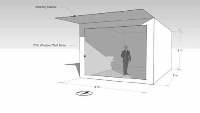The Potential of Predictive Modeling and Automated Building Facade Elements to Attain Thermal Comfort

Predictive modeling is a method used to predict future performance and foresee the significance of change. It can be used in a building to modify the present characteristics of the building to increase the future performance of thermal comfort. This paper explores the potential of using predictive modeling and the automation of facade elements to achieve thermal comfort in buildings, and in particular the use of weather forecasts to help a passive solar building use the usual high thermal lag time to its advantage. These are investigated through a review of the literature on predictive modeling and an energy simulation on a simple single zone room that is heated by direct gain passive solar. The simulation results show that predictive modeling has potential to keep a passive solar building in the thermal comfort zone on consecutive days of low solar radiation.
keywords: Predictive Modeling, Thermal Comfort, Passive Survivability, Passive Solar Building


Add comment
Log in to post comments